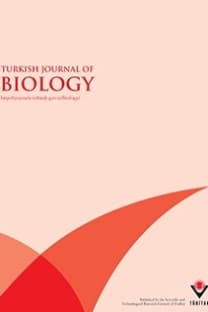Induction of apoptosis in the cervical cancer cell line HeLa by a novel metabolite extracted from the fungus Aspergillus japonicus Saito
Aspergillus japonicus, secondary metabolite, anticancer, HeLa cells, apoptosis, alkaloid
Induction of apoptosis in the cervical cancer cell line HeLa by a novel metabolite extracted from the fungus Aspergillus japonicus Saito
Aspergillus japonicus, secondary metabolite, anticancer, HeLa cells, apoptosis, alkaloid,
___
- Ali I, Wani WA, Saleem K (2011). Cancer scenario in India with future perspectives. Canc Ther 8: 56–70.
- Bladt TT, Frisvad JC, Knudsen PB, Larsen TO (2013). Anticancer and antifungal compounds from Aspergillus, Penicillium and other filamentous fungi. Molecules 18: 11338–11376.
- Bu’Lock JD (1961). Intermediary metabolism and antibiotic synthesis. Adv Appl Microbiol 3: 293–342.
- Calton GJ, Ranieri RL, Espenshade MA (1978). Quadrone, a new antitumor substance produced by Aspergillus terreus production, isolation and properties. J Antibiot 31: 39–44.
- Calvo MA, Wilson RA, Bok JW, Keller NP (2002). Relationship between secondary metabolism and fungal development. Microbiol Mol Biol Rev 66: 447–459.
- Cohen JJ (1993). Apoptosis. Immuno Today 14: 126–130.
- Demain AL Fang A (2000). The natural functions of secondary metabolites. Adv Biochem Eng Biotechnol 69: 1–39.
- Demain AL, Sanchez S (2009). Microbial drug discovery: 80 years of progress. J Antibio 62: 5–16.
- El-Kassas HY, Khairy HM (2009). A trial for biological control of a pathogenic fungus (Fusarium solani) by some marine microorganisms. American-Eurasian J Agric Environ Sci 5: 434–440.
- Gomez A, Gomez A (1984). Statistical Procedures for Agricultural Research. 2nd edn. New York, NY, USA: John Wiley and Sons, pp. 188–191.
- Harborne JB (1973). Phytochemicals Methods. London, UK: Chapman and Hall Ltd., pp. 49-188.
- Joshi VK, Attri D, Bala A, Bhushan S (2003). Microbial pigments. Ind J Biotech 2: 362–369.
- Kinghorn AD, Chin YW, Swanson SM (2009). Discovery of natural product anticancer agents from biodiverse organisms. Curr Opin Drug Discov Devel 12: 189–196.
- Lee Y, Shacter E (1999). Oxidative stress inhibits apoptosis in human lymphoma cells. J Biol Chem 274: 19792–19798.
- Mosmann T (1983). Rapid colorimetric assay for cellular growth and survival: application to proliferation and cytotoxicity assays. J Immunol Methods 16: 55–63.
- Nielsen KF, Smedsgaard J (2003). Fungal metabolite screening: database of 474 mycotoxins and fungal metabolites for dereplication by standardised liquid chromatography–UV– mass spectrometry methodology. J Chromatogr A 1002: 111– 136.
- Sawada K, Noda K, Nakajima H, Shimbara N, Furuichi Y, Sugimoto M (2005). Differential cytotoxicity of anticancer agents in pre- and post-immortal lymphoblastoid cell lines. Biol Pharm Bull 28: 1202–1207.
- Selim KA, El-Beih AA, AbdEl-Rahman TM, El-Diwany AI (2012). Biology of endophytic fungi. Curr Res Environ Appl Myco 2: 31–82.
- Sudarmono P, Utji R, Kardono LBS, Kumala S (2006). Cytotoxic assay of endophytic fungus 1.2.11 secondary metabolites from Brucea javanica (L) Merr towards cancer cell in vitro. Med J Indones 15: 137–144.
- Teoh YP, Don MM (2013). In vitro antifungal activities and phytochemical analysis of filamentous white-rot fungi, Schizophyllum commune Sains. Malaysiana 42: 1267–1272.
- Wainwright M (1992). An Introduction to Fungal Biotechnology. New York, NY, USA: John Wiley & Sons.
- ISSN: 1300-0152
- Yayın Aralığı: 6
- Yayıncı: TÜBİTAK
Genotoxic, cytotoxic, and apoptotic effects of crude extract of Usnea filipendula Stirt. in vitro
Serap ÇELİKLER KASIMOĞULLARI, Seyhan ORAN, Ferda ARI, Engin ULUKAYA
Current paradigms of cancer chemoprevention
Francesca CEPRANI, Franco SPIRITO, Roberto PIERGENTILI
Pınar OBAKAN, Gizem ALKURT, Betsi KÖSE, Ajda ÇOKER GÜRKAN, Elif Damla ARISAN, Deniz COŞKUN, Zeynep Narçin ÜNSAL
Hesna Begüm AKMAN, Ayşe Elif Erson BENSAN
Loss of heterozygosity in ING3 and ING5 genes in breast cancer
Esra GÜNDÜZ, Gökhan NAS, Muradiye ACAR, Eyyüp ÜÇTEPE
Muhammad MANSHA, Muhammad WASIM, Ali Raza AWAN, Asma Abdul LATIF
Sabire KARAÇALI, Savaş İZZETOĞLU, Remziye DEVECİ
Triumph or tragedy: progress in cancer
Ayşe Şebnem ERENLER, Hikmet GEÇKİL
Muhammad MANSHA, Muhammad WASIM, Ali Raza AWAN, Asma Abdul LATIF
